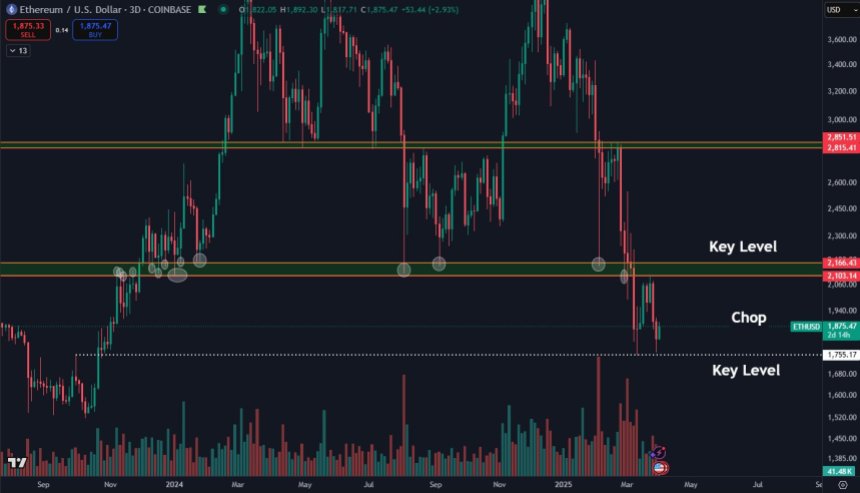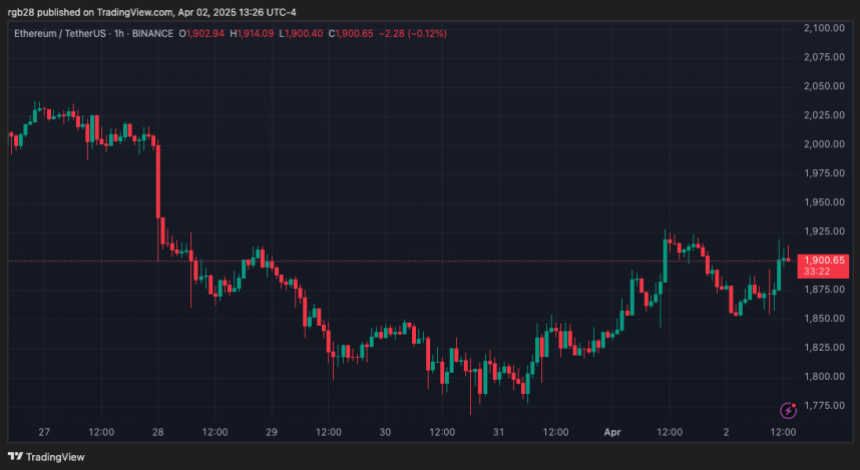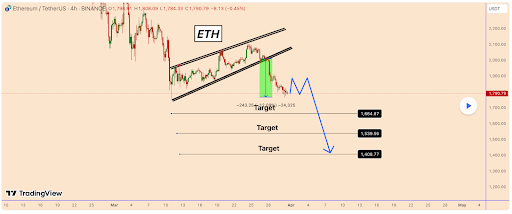Ethereum
Ethereum Is ‘Completely Dead’ As An Investment: Hedge Fund


In a post on X this past weekend, Quinn Thompson, Chief Investment Officer (CIO) of Lekker Capital, declared that Ethereum (ETH) is “completely dead” as an investment. His comments sparked a flurry of responses from prominent figures in the crypto industry, including Nic Carter of Castle Island Ventures, Columbia Business School professor Omid Malekan, and VB Capital’s Scott Johnsson.
Thompson, who oversees investments at Lekker Capital, set off the debate with a post stating: “Make no mistake, ETH as an investment is completely dead. A $225 billion market cap network that is seeing declines in transaction activity, user growth and fees/revenues. There is no investment case here. As a network with utility? Yes. As an investment? Absolutely not.”
He also shared a set of metrics to underscore Ethereum’s recent stagnation, including data on active addresses, transaction counts, and new address creation.

Is Ethereum ‘Dead’ As An Investment?
The provocative statement attracted immediate responses from prominent voices across the crypto ecosystem, triggering a debate over Ethereum’s economic and investment thesis, and specifically, the influence of Layer 2 (L2) scaling solutions on Ethereum’s native token economics.
Nic Carter, partner at Castle Island Ventures and co-founder of blockchain analytics firm Coinmetrics, swiftly responded, pinpointing Ethereum’s valuation dilemma squarely at the feet of its Layer 2 scaling implementations:“The #1 cause of this is greedy eth L2s siphoning value from the L1 and the social consensus that excess token creation was A-OK. Eth was buried in an avalanche of its own tokens. Died by its own hand.”
Thompson reinforced Carter’s criticism by suggesting that Ethereum’s community consensus had inadvertently favored token proliferation as a wealth-generation mechanism, ultimately undermining ETH’s investment narrative: “The social consensus among .eth’s in favor of excess tokens was because the creation of endless L2s, staking, restaking, DA, etc etc all enriched their pockets on the way up but no one wants to face the music now that the market is saying that was a mistake.”
However, this viewpoint was contested by Omid Malekan, professor at Columbia Business School and specialist in cryptocurrency and blockchain technology since 2019. Malekan underscored Layer 2s’ critical role in blockchain scalability and argued that any value-extraction by these secondary layers was not inherently detrimental to Ethereum’s foundational token economics: “L2s are the only viable way to scale any blockchain. Whether their tokens capture value or not is a separate question. But it can’t be that L2s ‘siphoned value from ETH’ yet didn’t capture value themselves. Security is not free.”
Malekan further challenged Thompson’s claim by questioning whether Ethereum could realistically become the first example in history of a widely adopted technological network whose utility failed to generate any meaningful financial return: “Is Ethereum going to be the first network ‘with utility’ in modern history where the network effects aren’t monetized? Can you provide any other examples of this happening?”
In response, Thompson clarified his argument, highlighting that monetization is indeed occurring within the Ethereum ecosystem, but not sufficiently accruing to ETH itself to validate the cryptocurrency’s current market capitalization. He illustrated this point with an analogy: “There’s tons of network effects being monetized all over the place, just not enough to ETH to justify its current valuation. Do all the network effects of the oil network and usage of oil accrue to oil?”
However, the oil analogy drew skepticism from Scott Johnsson, General Partner at VB Capital, who critiqued Thompson’s comparison due to Ethereum’s unique tokenomics, particularly its deflationary token burning mechanics influenced directly by network usage:
“I don’t disagree with your directional call, but I think this analogy falls flat. ETH ‘production’ is inversely correlated with usage, which is certainly not the case with oil. So as oil price increases, there is a demand response and a supply response. With ETH, it’s limited to the demand response. If ETH consumption looks like barrel consumption, then the price of ETH is far more likely to accrue value.”
Yet Thompson continued to disagree with Johnsson’s assessment, arguing that historical patterns do not necessarily support the claim of inverse correlation between Ethereum production and usage: “I disagree. We’ve never seen a sustained period of time where ‘ETH production is inversely correlated with usage.’ Obviously, the ‘production’ mechanics differ from oil, but similarly high ETH price is prohibitive to demand, hence L2s and cheaper alternative L1s.”
Acknowledging a possible misunderstanding, Johnsson clarified he was not predicting future Ethereum usage scenarios, emphasizing instead the theoretically inverse relationship between token burn and transaction volume under the current Ethereum network design: “I think we’re talking past each other a bit. I don’t think it’s arguable that if ETH usage increases that it leads to more burn and less inflation (production). I’m specifically not making future predictions on that usage. In any event, your ultimate point is fine imo because the demand side is so sensitive to really any cost.”
At press time, ETH traded at $1,793.

Featured image created with DALL.E, chart from TradingView.com

Editorial Process for bitcoinist is centered on delivering thoroughly researched, accurate, and unbiased content. We uphold strict sourcing standards, and each page undergoes diligent review by our team of top technology experts and seasoned editors. This process ensures the integrity, relevance, and value of our content for our readers.
Ethereum
Ethereum Faces ‘Hyperinflation Hellscape’—Analyst Reveals Key On-Chain Insights

Ethereum (ETH) continues to underperform in the broader cryptocurrency market, currently trading just below $1,800 after falling 4% in the past 24 hours. Despite a strong start to the year, where the crypto market experienced bullish momentum, ETH has failed to sustain its upward trajectory.
Since slipping below the $3,000 level, the asset has largely ranged downward and has now breached the $2,000 support zone, signaling weakening demand and sentiment.
While Bitcoin and other major digital assets still managed to see some recovery efforts in recent weeks, Ethereum’s price decline has been accompanied by decreasing network activity and weakening on-chain fundamentals.
This divergence has raised concerns over ETH’s short-term outlook and prompted a fresh analysis of the underlying causes driving the asset’s performance.
Fee Decline and Network Inactivity Fuel Inflationary Pressures
CryptoQuant analyst EgyHash recently published a report highlighting key on-chain metrics that suggest Ethereum’s current market weakness is closely tied to its declining fee economy and user activity.
According to the report titled: “Why Ethereum Is Bleeding Value: Fee Crash Meets Hyperinflation Hellscape.” Ethereum’s network is experiencing its lowest levels of activity since 2020.

Daily active addresses have declined steadily since early 2025, and average transaction fees have dropped to record lows. This reduction in activity has led to a sharp fall in Ethereum’s burn rate, a metric crucial in offsetting inflationary pressures following the network’s transition to proof-of-stake.
The Dencun upgrade, which was expected to enhance network efficiency, has coincided with an extended period of low transaction volumes, further reducing fee income and contributing to higher net ETH issuance.

EgyHash concludes that the confluence of weak network engagement, reduced burn rate, and high token inflation is central to Ethereum’s declining valuation.
Why Ethereum Is Bleeding Value
“Ethereum’s recent underperformance can be largely attributed to diminished network activity, as evidenced by declining active addresses and reduced transaction fees.” – By @EgyHashX pic.twitter.com/fgQJYCrOIn
— CryptoQuant.com (@cryptoquant_com) April 3, 2025
Ethereum Technical Outlook Signals Potential Support
Despite on-chain headwinds, some technical analysts maintain a cautiously optimistic view. Trader Courage, a technical analyst on X, noted that Ethereum is currently testing a major support zone and could rebound toward the upper resistance of its current trading range.
Back at the green support line. Looks like we could be heading towards the top of the range.
Key levels are on the chart.#Ethereum pic.twitter.com/rRX8b3b6nW
— Trader Courage
(@CryptoCourage1) April 3, 2025
Another market analyst, CryptoElite, shared a long-term ascending trendline that ETH has respected historically. Based on this trend, the analyst believes ETH could still have the potential to rally to $10,000 later in the year, provided broader market conditions improve.
Featured image created with DALL-E, Chart from TradingView
Ethereum
Ethereum Trading In ‘No Man’s Land’, Breakout A ‘Matter Of Time’?

Reason to trust

Strict editorial policy that focuses on accuracy, relevance, and impartiality
Created by industry experts and meticulously reviewed
The highest standards in reporting and publishing
Strict editorial policy that focuses on accuracy, relevance, and impartiality
Morbi pretium leo et nisl aliquam mollis. Quisque arcu lorem, ultricies quis pellentesque nec, ullamcorper eu odio.
Ethereum (ETH) continues failing to reclaim the $2,100 resistance, dropping 6% in the past week. As the second largest crypto trades within its “make or break” levels, some market watchers suggest it will continue to move sideways before another major move.
Related Reading
Ethereum Trades At 2023 Levels
After closing its worst Q1 since 2018, Ethereum continued moving sideways, hovering between the $1,775-$1,925 price range. Amid last Monday’s recovery, Ethereum traded only 6% below its monthly opening, eyeing a potential positive close in the monthly timeframe.
Nonetheless, the cryptocurrency fell over 10% from last week’s high to close the first quarter 45.4% below its January opening and 18.6% from its March opening. Moreover, it registers its worst performance in seven years, recording four consecutive months of bleeding for the first time since 2018.
Daan Crypto Trades noted that ETH is “still trading in no man’s land” despite its recent attempts to break above its current range. In early March, Ethereum dropped below the $2,100 mark, losing its 2024 gains and hitting a 16-month low of $1,750.

The trader suggested that the crucial levels to watch are a breakdown below $1,750 or a breakout above $2,100. “Anything in between is just going to be a painful chop,” he added.
Another market watcher, Merlijn The Trader, highlighted that ETH is at 2021 levels, pointing that it is trading within the breakout zone that led to Ethereum’s all-time high (ATH) but has stronger fundamentals and more institutional demand four years later.
“ETH is sitting on the same monthly support that ignited the 2021 bull run. Hold it, and $10K is in play. Lose it… and things get ugly,” he detailed.
More Chop Before ETH’s Next Move?
Analyst VirtualBacon considers that Ethereum will continue to trade within its current price range for the time being. He explained that ETH’s price has fallen to retest the last bear market resistance levels, as it has erased all its gains since November 2023.
The analyst considers this zone a “good value range” but doesn’t expect the cryptocurrency to break out “right away.” However, he added that a bullish breakout is “simply a matter of time” in longer timeframes.
“Ethereum always catches up when the Fed pivots and the global liquidity index beings to uptrend. That’s when you see the ETH/BTC ratio start to turn up again, leading the rest of the altcoin market,” he concluded.
Related Reading
Ali Martinez pointed out that the number of large ETH transactions has significantly declined in over a month, dropping 63.8% since February 25.
During this period, large transactions fell from 14,500 to 5,190, signaling a drop in whale activity on the network. He also noted that whales have sold 760,000 ETH in the last two weeks.
As of this writing, Ethereum trades at $1,903, a 6% drop in the weekly timeframe.

Featured Image from Unsplash.com, Chart from TradingView.com
Ethereum
Why A Massive Drop To $1,400 Could Rock The Underperformer

Reason to trust

Strict editorial policy that focuses on accuracy, relevance, and impartiality
Created by industry experts and meticulously reviewed
The highest standards in reporting and publishing
Strict editorial policy that focuses on accuracy, relevance, and impartiality
Morbi pretium leo et nisl aliquam mollis. Quisque arcu lorem, ultricies quis pellentesque nec, ullamcorper eu odio.
Crypto analyst Klejdi has indicated that Ethereum’s pain is far from over, with the second-largest crypto by market cap set to suffer a further downtrend. Specifically, he warned that ETH could still drop to as low as $1,400 before it finds a bottom.
Ethereum May Still Drop To As Low As $1,400
In a TradingView post, Kledji stated that Ethereum may drop to $1,400, providing a bearish outlook for the altcoin, which has underperformed other top cryptocurrencies. The analyst noted that ETH lost nearly 12% of its value within just three days after breaking out of its recent pattern last Friday.
Related Reading
He further mentioned that Ethereum’s movement and the rest of the crypto market are closely tied to Bitcoin. As such, this ETH crash is likely to happen, seeing as the flagship crypto has dropped to $81,300 and is already showing signs of further decline.
Klejdi highlighted in his accompanying chart that ETH will likely consolidate near its current level before continuing to move lower. However, the chart showed that the move to this $1,400 target will likely happen this month.

In the meantime, the analyst believes it would be wise to wait for Ethereum’s price to form another bearish pattern before entering a trade. He again reaffirmed that there is a strong possibility that ETH may extend its drop to $1,400.
Ethereum whales are already capitulating ahead of this projected price crash. Onchain analytics platform Lookonchain revealed an ETH OG that has sold off all its holdings. This investor bought 5,0001 ETH while trading at $277 in 2017 and didn’t sell when the altcoin hit its ATH during the last bull run. The whale started selling last month, possibly giving up on Ethereum making a comeback anytime soon.
ETH Will Still Reach New Highs
Crypto analyst Virtual Bacon is still confident that Ethereum will reach new highs. He noted that ETH is back at its key bear market breakout zone, retesting the $1,700 and $2,100 range. He predicts that the altcoin will continue to chop around this range in the short term. However, he remarked that Ethereum tends to catch up fast once the US Federal Reserve pivots and global liquidity turns.
Related Reading
Crypto analyst Crypto Patel affirmed that Ethereum’s biggest run is coming. He stated that Q2 to Q4 of this year will be life-changing for ETH. The analyst added that this could be the cycle top window and advised market participants not to miss it. Crypto Patel advised that they should accumulate between $1,900 and $1,300 with the target of between $7,000 and $10,000 in mind.
At the time of writing, the Ethereum price is trading at around $1,850, up in the last 24 hours, according to data from CoinMarketCap.
Featured image from iStock, chart from Tradingview.com
-

 Market20 hours ago
Market20 hours agoBitcoin’s Future After Trump Tariffs
-

 Market24 hours ago
Market24 hours agoIP Token Price Surges, but Weak Demand Hints at Reversal
-

 Ethereum23 hours ago
Ethereum23 hours agoEthereum Trading In ‘No Man’s Land’, Breakout A ‘Matter Of Time’?
-

 Altcoin23 hours ago
Altcoin23 hours agoJohn Squire Says XRP Could Spark A Wave of Early Retirements
-

 Market22 hours ago
Market22 hours ago10 Altcoins at Risk of Binance Delisting
-

 Market21 hours ago
Market21 hours agoEDGE Goes Live, RSR Added to Roadmap
-

 Regulation18 hours ago
Regulation18 hours agoUS Senate Banking Committee Approves Paul Atkins Nomination For SEC Chair Role
-

 Altcoin24 hours ago
Altcoin24 hours agoMovimiento millonario de Solana, SOLX es la mejor opción
























